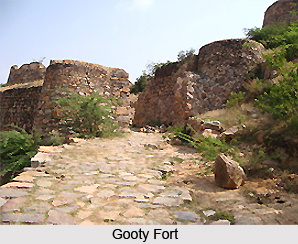 Gooty is a town located in the southern Indian state of Andhra Pradesh, particularly in Anantapur District. As per some of the oral accounts, Gooty has been existent since the era of the Ramayana. `Lakshmana Theertham` is the name of a pond inside the premises of Gooty Fort which provides fresh drinking water.
Gooty is a town located in the southern Indian state of Andhra Pradesh, particularly in Anantapur District. As per some of the oral accounts, Gooty has been existent since the era of the Ramayana. `Lakshmana Theertham` is the name of a pond inside the premises of Gooty Fort which provides fresh drinking water.
Historical sources have asserted that the region of Gooty was erected by the brother of Lord Rama, named Lakshmana, aimed to quench Sita`s thirst during their exile in the forest, which was referred to as `Aranyavasa`. Temples dedicated to these mythological deities are present in the grounds of the fort. During the 7th century, Gooty was termed as `Gowthamipuri` and it was ruled by King Ashoka several centuries ago. Yerragudi contains an ancient Ashokan rock edict which is about 6 kms away from Gooty. Sri Krishnadevaraya used to reign over the Vijayanagara Empire which included Gooty in the past, and Gooty was also under the control of the Pemmasani Nayaks of Gandikota. The Nayaks, however were subordinates of the Vijayanagar rulers. Much later, Gooty started to be ruled by Hyder Ali and subsequently by Tipu Sultan, the Nawab of Mysore.
Geography of Gooty
The geographical coordinates of Gooty is between 15.12 ° North and 77.63 ° East. It is situated at a distance of nearly 52 km from Anantapur District and is based at an altitude of 345 metres above mean sea level.
Gooty Fort
One of the most ancient hill forts of the state of Andhra Pradesh, called Gooty Fort is existent in Gooty town. Inscriptions in Sanskrit and Kannada language adorn the walls of this fort, which belongs to the 7th century. A particular inscription inside this fort mentions about a fort known as `Gadha` while yet another inscription of Bukka, who was the king of Vijanagara has referred to the Gooty Fort as being the `King of Forts`. Murari Rao, who supervised the Marathas then conquered the Gooty Fort which was controlled by the Subedar of Trichy Fort, according to the District Gazetter of Tiruchirapally. As per the records of `Gooty Kaifiyat`, Mir Jumla had taken control of Gooty Fort which finally passed under the charge of the chiefs of the Sultans of the Qutb Shahi Dynasty. During the year 1773, Hyder Ali attacked this fort but could not hold it for long since it slipped into the administrative control of the British during the British Raj in the country.
Browser was a British colonel who then conquered this fort and discovered that Zeruwar Khan, who was a Brahmin who converted into Islam was in charge of the premises of the Gooty Fort. The western portion of the hillocks contain shelter the citadel of the fort and currently it is represented by a gigantic mass of bare rock overshadows the adjoining ones. The fort is accessible with the aide of a path which was once known as `Mar Gooty`. The pathway then continues upwards, crisscrossing across steep sides of large masses of rocks and eventually reaching the summit of the fort. The fort possesses 15 main doors or `Mukhadwaralu` and the shape of the fort resembles that of a bell. A series of walls consisting of 14 gateways protected by bastions were present in the premises of the Gooty Fort. The buildings situated inside the Fort lack any architectural grandeur. On the borders of the cliff is located a polished lime stone termed as `Morari Rao`s seat` as well as two edifices. It is believed that this place was quite favoured by Morari Rao. Numerous wells are existent inside the rock clefts of the Fort and one of them is said to be linked to a stream at the foothills.



















